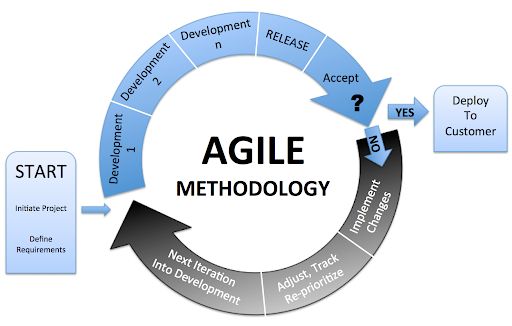
Leveraging Agile Methodology for Rapid Software Development in Startups

Agile methodology is a flexible and collaborative approach to software development. It focuses on breaking the development process into smaller, manageable tasks called "sprints," allowing teams to respond quickly to changes and customer feedback.
For startups, Agile offers several advantages that aid in rapid software development. This article will explore what Agile is and how its benefits can help startups develop software efficiently and effectively. Let's dive into the world of Agile and discover how it can boost your startup's success.
Agile Frameworks and Methodologies

Agile methodologies are flexible approaches to software development that help startups build software quickly and efficiently. Three common Agile frameworks are Scrum, Kanban, and Extreme Programming (XP). Startups must choose the right Agile method based on their needs. Agile principles align well with the Lean Startup philosophy, emphasizing continuous learning and customer feedback.
Setting Up Agile Practices in Startups
To set up Agile practices in startups, they should adopt Agile development processes, which involve breaking tasks into smaller, manageable chunks. Daily stand-up meetings and iterative development are important to keep the team aligned and progress on track.
Startups should also create a product backlog and a list of tasks and prioritize them based on importance to focus on what matters most. By following these practices, startups can rapidly develop software and adapt to changes efficiently.
Agile Sprint Planning and Execution
Agile methodology helps startups develop software faster and more efficiently. In Agile, we plan and organize our work in short periods called "sprints." During sprint planning, we set clear goals for what we want to achieve in each sprint. We create a "sprint backlog" listing all the tasks needed to reach our goals.
Also, we estimate the time each task will take. Once the sprint starts, we work on the tasks collaboratively. After the sprint ends, we have a review to see what we accomplished and a retrospective to learn from our experience and improve.
Agile Product Management and User Stories
In Agile, we focus on creating products that customers will love. We use "user stories" to understand what customers need and want. A user story is a simple description of a feature from the customer's perspective. For example, "As a user, I want to be able to save my progress in the app."
Writing effective user stories is essential for clear communication within the startup team. It helps everyone understand what to build. In product management, we involve stakeholders, like customers and investors, to ensure we're building the right things.
Agile Collaboration and Teamwork
Agile methodology is a way of working that helps startups develop software quickly and efficiently. It emphasizes teamwork and collaboration among team members. In Agile teams, everyone communicates and works closely to achieve goals. The teams are also organized in a way that allows them to handle different tasks and responsibilities, making them more flexible. To make things run smoothly, Agile teams hold regular meetings or "ceremonies" to plan, review progress, and make improvements.
Agile Tools and Project Management
Agile also relies on helpful tools and project management practices. Teams use tools like Jira or Trello to organize their work and keep track of tasks. They also integrate version control, which helps them manage software code changes. Continuous integration ensures that changes made by different team members are regularly combined into the project. These practices together form the foundation of Agile's effectiveness in rapid software development for startups.
Agile Quality Assurance and Testing
In startups, Agile methodology helps to develop software quickly and efficiently. Agile testing techniques involve continuous testing throughout the development process. It includes automated testing, where computers do some tests, and Test-Driven Development (TDD), where tests are written before writing the actual code.
These practices ensure the software works well and is bug-free, even with frequent updates and changes. It helps the team catch and fix problems early, smoothing the development process and ensuring the product meets the highest quality standards.
Agile and Minimum Viable Product (MVP)
Agile also works well with the Minimum Viable Product (MVP) approach in startups. MVP means creating a simple product version with the essential features to test the idea. Agile lets startups embrace this by supporting incremental feature development.
As the product is developed and released in small pieces, the team gathers user feedback and makes improvements based on that feedback. This iterative process helps startups to create a better final product that meets customers' needs and expectations.
Scaling Agile in Growing Startups
As startups grow, they face challenges in implementing Agile practices, a way of working that promotes flexibility and collaboration. Scaling Agile means applying these practices across larger teams and projects. It's not easy because it requires adapting to the organization's changing needs.
Several frameworks like SAFe and LeSS help with this process. Moreover, when teams work remotely, they must consider the unique challenges of distributed Agile. Overall, scaling Agile in startups requires careful planning and continuous improvement to keep the teams aligned and efficient.
Agile and Customer-Centric Development
In Agile, customer feedback is vital. It's a way of developing products that prioritize customers' needs and satisfaction. Agile teams regularly gather feedback and adapt their plans accordingly. To measure customer satisfaction, they use specific metrics that show how well their products meet customer expectations.
This way, Agile ensures that the development process is customer-centric. Integrating user feedback throughout the development cycle enables teams to deliver products that meet customers' needs and preferences.
Agile Deployment and Release Management
In startups, using Agile methodology for software development helps work faster and smarter. Continuous Deployment and Agile Release are essential parts of this approach. They allow developers to release new features and updates more frequently, improving the software and keeping customers happy.
Feature Toggles and A/B Testing enable trying out new features with some users before fully launching them. This reduces the risk of bugs and ensures the best features get implemented. Overall, Agile helps startups deliver their software to the market faster and with better quality.
Agile Project Risk Management
When working on projects in a startup using Agile, it's vital to identify and deal with potential risks. Agile helps by addressing technical debt, which means fixing issues and improving the software regularly. This prevents problems from piling up and causing bigger troubles later.
Contingency planning means being ready with backup plans if something goes wrong, and Agile adaptability allows the team to adjust and respond quickly to unexpected challenges. By managing risks well, startups can stay on track and complete their projects successfully.
Measuring Agile Performance and Success
When using Agile methods in a startup, measuring how well things are going is essential. Agile KPIs help track progress and success. These are signs showing if the startup is on the right track. Evaluating the team's performance is crucial too. Are they working well together and delivering results? Continuous improvement means always finding ways to improve, and Agile metrics help with that.
Agile in Startup Culture and Leadership
In a startup, being Agile means being adaptable and open to change. It's about embracing flexible ways of working. Leaders play a vital role in empowering teams and supporting an Agile culture. They should lead by example and encourage collaboration. Transforming a startup into an Agile organization can lead to better innovation and quicker responses to challenges. It's about fostering a dynamic and responsive environment where everyone's ideas are valued.
Furthermore, integrating thelean Startup Methodology for software development can enhance this Agile approach. The Lean Startup Methodology emphasizes iterative development, validated learning, and continuous improvement, allowing startups to build products that meet customer needs efficiently and effectively. By combining Agile principles with the Lean Startup Methodology, startups can maximize their potential for success in today's rapidly changing business landscape.
Conclusion
Using Agile Methodology in startups can greatly speed up software development. Teams can quickly adapt and improve their products by breaking tasks into small, manageable chunks and continuously getting feedback.
Agile practices foster innovation and growth, making it an excellent approach for startups looking to stay flexible and deliver high-quality software efficiently. The benefits of agile development for startupsare evident in its ability to promote collaboration, enhance customer satisfaction, and provide a clear, transparent development process.
Post
| By | google_user_7890 |
| Added | Aug 22 '2023, 7:37 |

